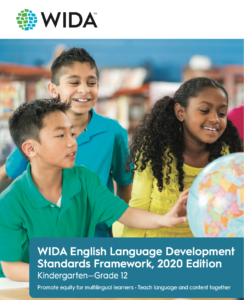 by James C. Sherlock
by James C. Sherlock
We will briefly discuss here English learners in Virginia schools and the enormous impact they have. They truly offer to enrich the experience of all kids in our schools, but they need a lot of help and there are a great many of them.
There were 104,411 English learner students enrolled in Virginia public schools in 2020-21, about 8% of the total enrollment. See the breakdown by school division here.
That was down more than 12,000 from the year before, perhaps reflecting COVID-related failures to register for school rather than leaving the state. We are about to find out.
The 2019-20 numbers represented a 44% increase in 10 years.
The huge influx of kids on our southern border this year will affect these numbers next month, but we have no idea how much because we don’t know where they have gone.
A lot of these kids, in addition to the challenges of language barriers, are also what are designated Students with Limited or Interrupted Formal Education (SLIFE). VDOE does not yet collect data on that sub-group.
It is easy to predict that those kids may have had a harder time with remote learning than native English speakers. In recognition of that problem, English learners were given priority for return to school in person in some districts.
Federal and state English learner programs provide vital support to schools and the children they serve, and we all depend upon their proper and effective functioning.
Those kids as a group will need extra help in the upcoming school year. We hope it will be there.
Federal Programs. Federal funds are distributed to Virginia schools under various Titles and Parts of Elementary and Secondary Education Act (ESEA) of 1965 as amended.
- Title I, Part A, Improving Basic Programs
- Title I, Part C, Education of Migratory Children
- Title I, Part D, Subpart 1 and 2 Neglected, Delinquent, or At-Risk
- Title II, Part A, Teacher and Principal Training and Recruiting Fund
- Title III, Part A, Language Instruction for Limited English Proficient and Immigrant Students
- Title IV, Part A, Student Support and Academic Enrichment Grants
- Title V, Part B, Subpart 2, Rural and Low-income School Program
Because this is federal money disbursed and used under federal rules, it is up to the Virginia Department of Education and the school districts to monitor the success of the programs at the individual school levels and report up the chain.
Title III, Part A, Language Instruction for Limited English Proficient and Immigrant Students is one of the federal programs that helps fund Virginia schools. Title I also helps support English learners.
Both come with state monitoring requirements that accompany the federal money. Many of those programs’ reporting and monitoring requirements were suspended during COVID.
State and Local Rules and Funding. State and local money extends the federal contributions at various levels depending upon the program.
The Code of Virginia addresses English Learner education in the following
- English as the language of instruction § 22.1-212.1
- Identification of limited English proficient students § 22.1-253.13:1. (D)( 12)
- Enrollment of ELLs over age 18 § 22.1-5. (D)
- Funding § 22.1- 199.1 (5)(D)
- Staffing §22.1-253.13:2. (F)
- High Quality Professional Development § 22.1-253.13:5. (E)
Scope of ELL instruction in Virginia.
Those 104,411 English learner students enrolled in Virginia pre-K-12 public schools in 2020 to 2021 spoke 245 different languages.
Prominent examples:
- Fairfax County enrolled 30,178 English learners, only 65% of whom had Spanish as their native tongue. The rest, nearly 11,000 students, spoke 149 different non-Spanish languages.
- In Prince William County, 15,497 students spoke 106 different languages.
- Loudoun County enrolled 9,269 English learners who spoke 113 languages.
Other interesting examples.
- York County Public Schools had 297 English learners, but only 101 spoke Spanish. There were 46 other languages spoken.
- Lots of kids speak the various languages of South Asia including Dari (Afghanistan) (1,229), Hindi (408), Bengali (739), Marathi (71), Telugu (918) concentrated in Loudoun (531), Tamil (299), Gujarati (227), Kannada (46), Odia (11), Malayalam (123), Punjabi (36), Nepali (670), Urdu (Pakistan) (2,197); Punjabi (Pakistan and India) (36), Pashto (Afghanistan and Pakistan) (1540), and Sindhi (13). Some school districts list Afghan as a language (82 more kids).
- Quekchi speakers (one of the Mayan languages, spoken within Qʼeqchiʼ communities in Guatemala and Belize) are concentrated in Culpeper.
- More than 1,700 kids speak Amharic (Ethiopia). They are concentrated in Northern Virginia, with 800 in Fairfax alone. Swahili speakers (384) are widely spread around the state. Somali’s (179) are concentrated in Fairfax County; Twi speakers (Uganda) (849) in Fairfax and Prince William.
- Speakers of the various dialects of Chinese (1,124) have concentrations in Northern Virginia but are pretty widely spread out across the state. Mongolian speakers (221) are concentrated in Arlington (148). There were only 43 Uighur speakers in Virginia public schools.
- Rockingham County and encapsulated Harrisonburg have a surprising number (59) of Russian speaker schoolchildren. Most of the rest (total 575) are in Northern Virginia.
Teachers.
The Virginia state regulation on an endorsement to qualify teachers of English as a Second Language are contained in 8VAC20-23-350
Virginia is a World-Class Instructional Design & Assessment (WIDA) Consortium member and subscribes to the WIDA English Language Development Standards Framework, 2020 Edition, Kindergarten—Grade 12. The overarching goal is to teach language and content together.
There is in Virginia a chronic shortage of teachers with the proper training.
Bottom line. This teaching is vital.
We hope it does not get lost in the overwhelming amount of churn in every other instructional program in Virginia as a result of the last two General Assembly sessions and subsequent VDOE rule making.

Leave a Reply
You must be logged in to post a comment.